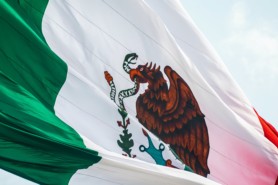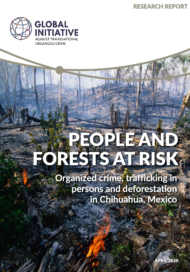Posted on 21 Jun 2021
Between 2011 and 2017, three high-level Mexican officials helped transform the Mexican state of Nayarit into an ‘estado narco’. Efforts to bring them to justice have had mixed results, while crime and politics in Nayarit remain as enmeshed as ever, with devastating cost.
On the morning of 6 June 2021, fugitive Mexican politician Roberto Sandoval was finally arrested after seven months on the run. During Sandoval’s term as governor of Nayarit from 2011 to 2017, the Pacific coast state became a case study for corruption and collusion with organized crime, with police routinely supporting criminal activities and authorities receiving hefty bribes. Sandoval’s top law enforcement official, Edgar Veytia, is currently imprisoned in the United States after pleading guilty to drug trafficking charges.
General Salvador Cienfuegos Zepeda, Mexico’s secretary of defence between 2012 and 2018, has also been accused of involvement in drug trafficking in connection with Nayarit. On 15 October 2020, Cienfuegos was detained in Los Angeles on charges including conspiracy to distribute heroin, cocaine, methamphetamine and marijuana in the US, allegedly working on behalf of the Nayarit-based H-2 Cartel. Cienfuegos denied the charges, and after a month of behind-the-scenes wrangling, US attorney general William Barr ordered his release, citing ‘sensitive and important foreign policy considerations’. Mexican authorities subsequently declined to initiate a prosecution case against Cienfuegos.
Fertile ground for crime and corruption
The story of how these three officials transformed Nayarit into an ‘estado narco’ is rooted in the state’s long association with the drug trade. Nayarit’s highlands are some of Mexico’s primary opium-growing zones, and by the 1960s the state was a strategically important setting for the trafficking of drugs north towards the US consumer markets. Government representatives at all levels were directly involved in the running of the drug trade in Nayarit, although there were occasional army crackdowns, skirmishes between rival traffickers and the killing of state officials on the orders of organized crime.
Violence related to the drug trade began to surge in Nayarit after President Felipe Calderón’s 2006 declaration of ‘war’ on the nation’s cartels. By 2010, the state capital, Tepic, had a murder rate of 229 for every 100 000 inhabitants and was ranked the 13th most dangerous city in the world. The year 2011 was even bloodier, with 456 murders recorded across the state. Enter Roberto Sandoval, who won the 2011 gubernatorial election after assuring Nayarit’s electorate that only he could put a stop to the violence.
Edgar Veytia, Sandoval’s assistant (but de facto chief) state attorney general, was charged with making good on Sandoval’s promise. Veytia declared that there was ‘no room for organized crime’ in Nayarit, and the numbers appeared to show he meant business: homicides fell by 75 per cent in four years; public shoot-outs between rival cartel gunmen became less frequent; and by 2016, Nayarit ranked number two on the Mexico Peace Index, and was lauded by president Peña Nieto.
But what Veytia had actually done, in the words of journalist Diego Petersen, was to ‘hand over the drugs market [to the mafia]. Nayarit put the safety of the state in the hands of organized crime – and in the short term, it worked.’ Using his position, he was able to consolidate a pre-existing relationship with Juan Francisco Patrón Sánchez, the head of the Beltrán Leyva cartel in Nayarit whose codename (‘H-2’) would eventually become shorthand for the criminal organization. Veytia gave H-2 complete control over drug trafficking in the state, and from 2011 helped the gang members to locate and assassinate their Sinaloa Cartel rivals. According to witnesses in Compostela, every week officers of the Nayarit police would escort a truck full of H-2 gunmen into their town to help them ‘disappear people’. Veytia also made sure that any H-2 members who were arrested were always quickly freed.
Both sides gained from the partnership: Sandoval allegedly grew extremely rich from his ties to organized crime, as did Veytia, who earned money from embezzlement, kidnapping, murder-for-hire, extortion and the seizure of land. Soon Veytia became involved in trafficking drugs and was rumoured to have used his bus franchise to smuggle marijuana, as well as heroin processed in laboratories that he operated in Nayarit’s mountains. US authorities estimated Veytia earned a total of US$250 million from such illicit activities. And at the same time, Patrón Sánchez rose up within the ranks of the Beltrán Leyva organization, taking full command of the group after Héctor Beltrán Leyva was arrested in 2014.
Their collective successes may have attracted the attention of General Cienfuegos. According to the subsequently dropped US allegation, Cienfuegos advised Patrón Sánchez about US investigations into his activities; alerted him to the presence of informants within his organization (which led Patrón Sánchez to order at least one murder); and made sure his subordinates in the Mexican security forces refrained from interfering in the H-2 cartel’s operations.
Things fall apart
However mutually beneficial the relationships had been, in 2017 the alliance between Patrón Sánchez, Veytia, Sandoval and Cienfuegos fell apart in truly spectacular fashion. On 9 February, Patrón Sánchez and seven of his men were killed in a joint operation between Veytia’s police forces and the navy in Tepic. The next morning, another joint force of marines and Veytia’s officers killed the Beltrán Leyva organization’s second-in-command, Daniel Isaac Silva Gárate (codenamed H-9), in an ambush in another part of Tepic. It would seem that the Jalisco New Generation Cartel, who now moved into Nayarit en masse, had outbid Patrón Sánchez and become Veytia’s new paymasters.
Just five weeks later, however, Veytia miscalculated – or was perhaps himself betrayed – and on one of his twice monthly trips to San Diego to visit family was detained at the US border. A federal grand jury in New York City charged him with conspiracy to manufacture, import and distribute heroin, cocaine, methamphetamine and marijuana between 2013 and 2017. After a two-year trial, Judge Carol Amon found him guilty of these charges on 26 September 2019 and sentenced him to 20 years in prison.
Veytia’s arrest had led the Mexican federal prosecutor’s office and lawmakers in Nayarit to open a joint investigation into Sandoval in mid-2017. Subsequently, in early 2019, the US Treasury Department imposed sanctions on Sandoval, his wife and their two adult children, who had ‘acted or purported to act on his behalf by holding his ill-gotten assets in their names’. In February 2020, and apparently on the basis of evidence given by Veytia as part of a sentencing deal, the US State Department indicted Sandoval, alleging he had ‘misappropriated state assets and received bribes from narcotics trafficking organizations, including the Jalisco New Generation Cartel (CJNG) [and] the Beltran Leyva Organization’. On 13 November, the Mexican prosecutor’s office issued a warrant for Sandoval’s arrest on charges of ‘embezzlement, graft and corruption’. His name was added to INTERPOL’s red list, while the Mexican president, Andrés Manuel López Obrador, urged him to turn himself in and face justice.
But it now appears that Sandoval’s was not the only name Veytia shared with US authorities. In August 2019, just a month before Veytia’s final sentencing, an indictment was filed in the same court (Eastern District of New York) accusing Cienfuegos of also collaborating with the H-2 cartel. According to journalist Laura Sánchez Ley, Veytia had turned informant in order to secure a shorter jail sentence, and it was this indictment that led to the Cienfuegos arrest in the US and revealed his place in the Nayarit corruption story.
Justice?
That Edgar Veytia was eventually arrested, tried and convicted for his part in this story is somewhat heartening, as are the measures taken against Roberto Sandoval, although these developments may be but cold comfort for Nayarit’s beleaguered population. Since 2017, the state has plunged back into chaos, with public shoot-outs erupting between Beltrán Leyva remnants and the marauding Jalisco New Generation Cartel, the latter now backed by Veytia’s successor as state attorney general, Javier Herrera Valle. During the two years that Herrera Valle spent as the security chief, an estimated 1 500 killings were linked to the state’s new drug war, as well as close to another 1 400 disappearances. Up until May 2019, 130 of the ‘disappeared’ had been found buried in 29 mass graves.
The story of Nayarit illustrates the deadly consequences of corruption in the context of the Mexican ‘drug war’, and also the dangers of assuming that, in the same context, a pax mafiosa can ever be truly ‘peaceful’. Cienfuegos’s surprise release is also a troubling reminder of the deeply intertwined nature of military power, political influence and economic opportunity – both licit and illicit – in Mexico.
In Nayarit, in many ways, the beat goes on. Crime and politics are continuing their decades-long dance, just with different partners.
A longer version of this essay was originally published by the Mexico Violence Resource Project, which is supported by the Global Initiative Against Transnational Organized Crime. It is available here.
photo: Nathaniel Morris



